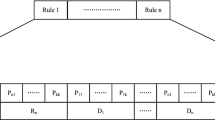Abstract
Association Rule Mining is one of the important data mining activities and has received substantial attention in the literature. Association rule mining is a computationally and I/O intensive task. In this paper, we propose a solution approach for mining optimized fuzzy association rules of different orders. We also propose an approach to define membership functions for all the continuous attributes in a database by using clustering techniques. Although single objective genetic algorithms are used extensively, they degenerate the solution. In our approach, extraction and optimization of fuzzy association rules are done together using multi-objective genetic algorithm by considering the objectives such as fuzzy support, fuzzy confidence and rule length. The effectiveness of the proposed approach is tested using computer activity dataset to analyze the performance of a multi processor system and network audit data to detect anomaly based intrusions. Experiments show that the proposed method is efficient in many scenarios.









Similar content being viewed by others
References
Agrawal R, Imielinski T, Swami A (1993) Mining association rules between sets of Items in large databases. In: Proceedings of the ACM SIGMOD international conference, Washington, pp 207–216
Gyenesei A (2000b) A fuzzy approach for mining quantitative association rules. TUCS Technical Report No. 336, pp 1–18
Ng RT, Han J (1994) Efficient and effective clustering methods for spatial data mining. In: Proceedings of the 20th VLDB conference, pp 144–155
Srikant R, Agrawal R (1996) Mining quantitative association rules in large relational tables. In: Proceedings of the ACM SIGMOD internationl conference, Canada, pp 1–12
Gyenesei A (2000a) Mining weighted association rules for fuzzy quantitative items TUCS Technical Report No. 346, pp 1–12
Yager RR (1996) On linguistic summaries of data, knowledge discovery in database, pp 347–363
Chan KCC, Au W (1997) Mining fuzzy association rules. In: Proceedings of the sixth international conference on information and knowledge management, pp 209–215
Au W-H, Chan KCC (2003) Mining fuzzy association rules in a bank-account database. IEEE Trans Fuzzy Syst, 11(2)
Fonseca CM, Fleming PJ (1993) Genetic algorithms for multiobjective optimization: formulataion, discussion and generalization. In: Proceedings of fifth international conference on genetic algorithms, pp 416–423
Goldberg DE (1989) Genetic algorithms for search, optimization and machine learning. Addison-Wesley, Reading
Lunt T (1993) Detecting intruders in computer systems. In: Proceedings of 1993 conference on auditing and computer technology
Ilgun K, A Kemmerer (1995) State transition analysis: a rule-based intrusion detection approach. IEEE Trans Softw Eng 21(3):181–99
Teng H, Chen K, Lu S (1990) Adaptive real-time anomaly detection using inductively generated sequential patterns. In: Proceedings of IEEE computer society symposium on research in security and privacy, California, pp 278–84
Debar H, Becker M, Siboni D (1992) A neural network component for an intrusion detection system. In: Proceedings of IEEE computer society symposium on research in security and privacy, California, pp 240–50
Lee W, Stolfo S, Mok K (1998) Mining audit data to build intrusion detection models. In: Proceedings of the fourth international conference on knowledge discovery and data mining, New York, pp 66–72
Bridges SM, Vaughn RB (2000) Fuzzy data mining and genetic algorithms applied to intrusion detection. In: The national information systems security conference, Baltimore
Kuok CM, Fu A, Wong MH (1998) Mining fuzzy association rules in databases. In: Proceedings of the ACM SIGMOD conference on management of data, pp 41–46
Zhang W (1999) Mining fuzzy quantitative association rules. In: Proceedings of 11th IEEE international conference on tools with artificial intelligence, pp 99–102
Ishibuchi H, Nakashima T, Murata T (2001) Three-objective genetics-based machine learning for linguistic rule extraction. Inf Sci 136:109–133
Barandela R, Valdovinos RM, Sanchez JS (2003) New applications of ensembles of classifiers. Pattern Anal Appl 6:245–256
Kaya M, Alhajj R (2003) Facilitating fuzzy association rules mining by using multi-objective genetic algorithms for automated clustering. In: Proceedings of the third IEEE international conference on data mining (ICDM’03), pp 561–564
Deb K, Pratap A, Agarwal S, Meyarivan TA (2002) Fast and elitist multi-objective genetic algorithm: NSGA-II. IEEE Trans Evol Comput 6(2):181–197
Bezdek JC (1981) Pattern recognition with fuzzy objective function algorithms. Plenum, New York
Au W-H, Chan KCC (1999) FARM: a data mining system for discovering fuzzy association rules. In: Proceedings of 8th IEEE international conference on fuzzy systems, Seoul, Korea, pp 1217-1222
Laumanns M, Thiele L, Deb K, Zitzler E (2002) Combining convergence and diversity in evolutionary multiobjective optimization. Evol Comput J 10(3):263–282
Computer Activity Dataset: http://delve/data/compactiv/compActivDetail.html
TCPdump Dataset: http://iris.cs.uml.edu:8080/network.html
Author information
Authors and Affiliations
Corresponding author
Rights and permissions
About this article
Cite this article
Santhi Thilagam, P., Ananthanarayana, V.S. Extraction and optimization of fuzzy association rules using multi-objective genetic algorithm. Pattern Anal Applic 11, 159–168 (2008). https://doi.org/10.1007/s10044-007-0090-x
Received:
Accepted:
Published:
Issue Date:
DOI: https://doi.org/10.1007/s10044-007-0090-x




